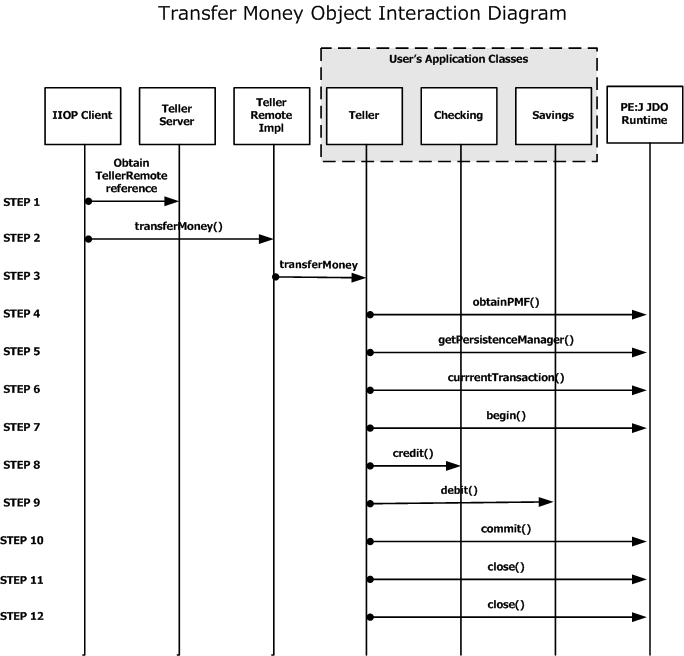Remoting JDO objects using RMI
| Note |
| To
work with any of these samples, you will need the
following: .........................................JDK 1.2 or higher (I use JDK 1.3.1) .........................................PE:JTM - The Productivity Environment for JavaTM (from HYWY Software Corporation) |
| Note: This article assumes that the reader has already created simple bank project using PE:J and JDO. |
The Transfer Money Object Interaction Diagram is as shown below:

The Transfer Money logic is as follows:
The IIOP Client (IIOPClient.java) obtains a reference to the TellerRemote (TellerRemote.java) remote object from Teller Server (TellerServer.java).
The IIOP Client (IIOPClient.java) invokes the transferMoney() method of the TellerRemote (TellerRemote.java) object.
The TellerRemote (TellerRemote.java) invokes the TransferMoney() method on the JDO Client (Teller.java).
The JDO Client (Teller.java) obtains a configured PersistenceManagerFactory from the JDOAdapter.
The JDO Client (Teller.java) uses the configured PMF to get a PersistenceManager.
The JDO Client (Teller.java) uses the Persistence Manager to obtain a Transaction object.
The JDO Client (Teller.java) begins a new Transaction using the Transaction object.
The JDO Client (Teller.java) invokes the credit method on the Checking object.
The JDO Client (Teller.java) then invokes the debit method on the Savings object.
The JDO Client (Teller.java) then commits the transaction by invoking the method in the Transaction object.
The JDO Client (Teller.java) then closes the Persistence Manager.
The JDO Client (Teller.java) then closes the JDOAdapter.
| com/hywy/samples/remote/iiop/TellerServer.java | |
2: 3: 4: 5: 6: 7: 8: 9: 10: 11: 12: 13: 14: 15: 16: 17: 18: 19: 20: 21: 22: 23: 24: 25: 26: 27: 28: 29: 30: 31: 32: 33: 34: 35: 36: 37: 38: 39: 40: 41: 42: 43: 44: 45: 46: 47: 48: 49: 50: 51: 52: 53: 54: 55: 56: 57: 58: 59: 60: 61: 62: 63: 64: |
* The following example illustrates an RMI-IIOP Server * * author: Gopalan Suresh Raj * Copyright (c), 2002. All Rights Reserved. * URL: https://gsraj.tripod.com/ * email: gopalan@gmx.net */ /////////////////////////////////////////////////////////////////////////////////////////////////////////////////////////////// // To Run // start tnameserv -ORBInitialPort 1000 // start java -classpath .;C:\PEJ\lib\jdo.jar;C:\PEJ\lib\j2ee.jar;C:\PEJ\lib\pej.jar; com.hywy.samples.remote.iiop.TellerServer /////////////////////////////////////////////////////////////////////////////////////////////////////////////////////////////// package com.hywy.samples.remote.iiop; import java.util.Properties; import javax.naming.InitialContext; import javax.rmi.PortableRemoteObject; import com.hywy.samples.remote.TellerRemoteImpl; /** * Creates a Server and binds the RMI Servant with the IIOP Registry * * Pre-requisites: You will need to have the COS naming server * running for the registration code to work. * * @author Gopalan Suresh Raj */ public class TellerServer { public static final String CONTEXT_NAME = "java.naming.factory.initial"; public static final String IIOP_STRING = "com.sun.jndi.cosnaming.CNCtxFactory"; public static final String URL_NAME = "java.naming.provider.url"; public static final String IIOP_URL_STRING = "iiop://localhost:1000"; /** * Entry Point to this application */ public static void main(String[] args) { try { // Create the Object TellerRemoteImpl myObject = new TellerRemoteImpl(); // Create the IIOP Initial Context Properties iiopProperties = new Properties(); iiopProperties.put( TellerServer.CONTEXT_NAME, TellerServer.IIOP_STRING ); iiopProperties.put( TellerServer.URL_NAME, TellerServer.IIOP_URL_STRING ); InitialContext iiopContext = new InitialContext( iiopProperties ); // Bind the object to the IIOP registry iiopContext.rebind( "TELLER", myObject ); System.out.println( "TellerServer bound in the IIOP Registry as TELLER and is up and ready for eCommerce..." ); } catch ( Exception exception ) { exception.printStackTrace (); } } } |
click here to go to
My JDO
HomePage...
click here to go
to
My
Advanced Java Tutorial Page...
| About the Author... |
| Gopalan Suresh Raj is a Software Architect, Developer and an active Author. He has co-authored a number of books including "Professional JMS", "Enterprise Java Computing-Applications and Architecture" and "The Awesome Power of JavaBeans". His expertise spans enterprise component architectures and distributed object computing. Visit him at his Web Cornucopia© site (https://gsraj.tripod.com/) or mail him at gopalan@gmx.net. |
This site was developed and is maintained by Gopalan Suresh Raj This page has been visited |
||
Last Updated : Feb 26, 2002 |
||
Copyright (c) 1997-2002, Gopalan Suresh Raj - All rights reserved. Terms of use. |
All products and companies mentioned at this site are trademarks of their respective owners. |